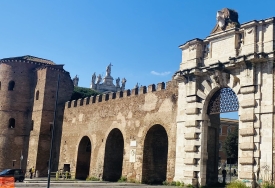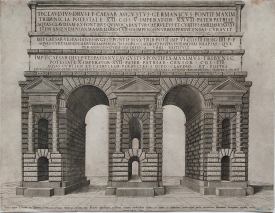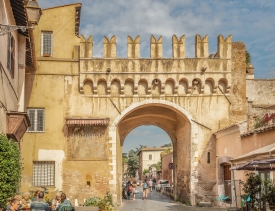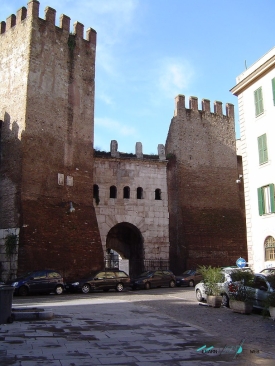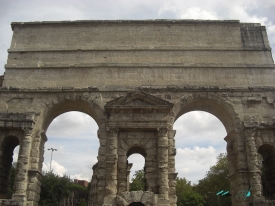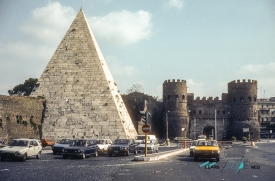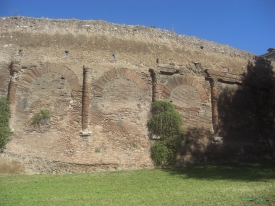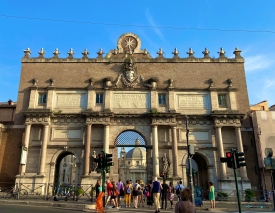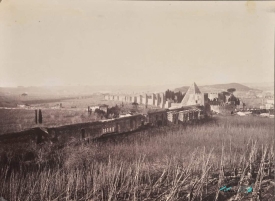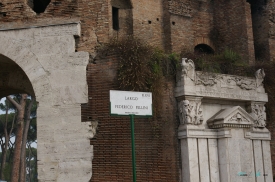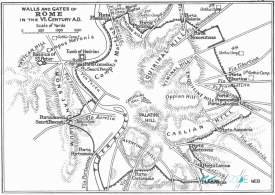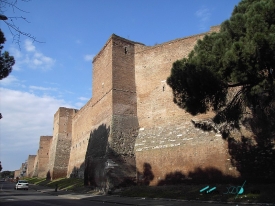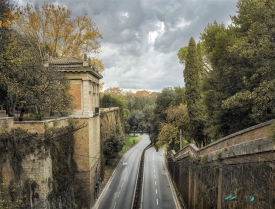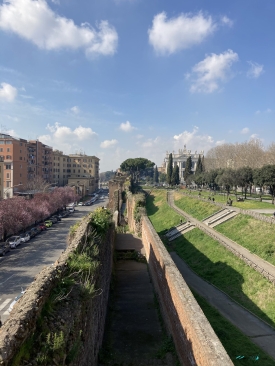The Aurelian Walls are a series of defensive walls that were built in the 3rd century AD to protect the city of Rome. They were named after the Emperor Aurelian, who ordered their construction.
The Aurelian Walls were built during a time when Rome was under threat from invading barbarian tribes. The city's existing defenses had fallen into disrepair, and Aurelian realized that new walls were needed to protect the city from attack.
Construction of the walls began in 271 AD and was completed in 275 AD. The walls were constructed using brick and concrete and stretched for 19 kilometers (11.8 miles) around the city of Rome. The walls were up to 8 meters (26 feet) high and 3.5 meters (11.5 feet) thick, and included 383 towers and 18 gates.
Today, the Aurelian Walls still surround much of the historic center of Rome. Some of the most popular sections of the walls to visit include the sections near Porta San Giovanni, Porta San Sebastiano, and Porta Pinciana. Visitors can also see sections of the walls near the Vatican and the Colosseum.
The Aurelian Walls are located in central Rome and are easily accessible by public transportation. Visitors can take the metro to stops such as Colosseo, Piramide, or San Giovanni and then walk to the sections of the walls they want to visit. There are also several bus routes that stop near the walls.
The Aurelian Walls are a popular attraction for visitors to Rome who are interested in the city's rich history and architecture. They are an impressive feat of engineering and remain an important symbol of Rome's enduring power and influence.
The construction of the walls was a massive undertaking that required a large workforce. It's estimated that as many as 100,000 workers were involved in building the walls.
The Aurelian Walls were not the first set of walls to surround Rome. In fact, there were several previous sets of walls, some of which were built by the ancient Romans themselves.
Despite their impressive size and strength, the Aurelian Walls were breached several times throughout history. One notable breach occurred in 1527 when the army of Charles V, the Holy Roman Emperor, sacked the city of Rome.
Some sections of the Aurelian Walls were incorporated into later buildings, such as churches and palaces. For example, the Basilica of San Giovanni in Laterano was built into a section of the walls.
In the early 20th century, parts of the walls were demolished to make way for modern buildings and roads. However, many sections of the walls still remain intact and can be visited by tourists today.
the Aurelian Walls included 18 gates, which served as the main points of entry and exit to the city of Rome. Each gate had a specific purpose and name, and some were more heavily fortified than others. Here are the names of the 18 gates of the Aurelian Walls, listed in clockwise order starting from the northeast:
Porta del Popolo
Porta Pinciana
Porta Salaria
Porta Nomentana
Porta Tiburtina
Porta Praenestina
Porta Latina
Porta Appia
Porta Ardeatina
Porta San Sebastiano
Porta Ostiense
Porta Portuensis
Porta Aurelia
Porta Cornelia
Porta Flaminia
Porta Pia
Porta Tiburtina Valeria
Porta Metronia
Today, some of these gates are still standing, while others have been partially or completely destroyed over time. Porta San Sebastiano, for example, is one of the best-preserved gates and now houses the Museum of the Walls, where visitors can learn more about the history of the Aurelian Walls and their construction.
History
The Aurelian Walls were built during a time when Rome was under threat from invading barbarian tribes. The city's existing defenses had fallen into disrepair, and Aurelian realized that new walls were needed to protect the city from attack.
Construction
Construction of the walls began in 271 AD and was completed in 275 AD. The walls were constructed using brick and concrete and stretched for 19 kilometers (11.8 miles) around the city of Rome. The walls were up to 8 meters (26 feet) high and 3.5 meters (11.5 feet) thick, and included 383 towers and 18 gates.
Location
Today, the Aurelian Walls still surround much of the historic center of Rome. Some of the most popular sections of the walls to visit include the sections near Porta San Giovanni, Porta San Sebastiano, and Porta Pinciana. Visitors can also see sections of the walls near the Vatican and the Colosseum.
How to arrive
The Aurelian Walls are located in central Rome and are easily accessible by public transportation. Visitors can take the metro to stops such as Colosseo, Piramide, or San Giovanni and then walk to the sections of the walls they want to visit. There are also several bus routes that stop near the walls.
The Aurelian Walls are a popular attraction for visitors to Rome who are interested in the city's rich history and architecture. They are an impressive feat of engineering and remain an important symbol of Rome's enduring power and influence.
Interesting facts about the Aurelian Walls
The construction of the walls was a massive undertaking that required a large workforce. It's estimated that as many as 100,000 workers were involved in building the walls.
The Aurelian Walls were not the first set of walls to surround Rome. In fact, there were several previous sets of walls, some of which were built by the ancient Romans themselves.
Despite their impressive size and strength, the Aurelian Walls were breached several times throughout history. One notable breach occurred in 1527 when the army of Charles V, the Holy Roman Emperor, sacked the city of Rome.
Some sections of the Aurelian Walls were incorporated into later buildings, such as churches and palaces. For example, the Basilica of San Giovanni in Laterano was built into a section of the walls.
In the early 20th century, parts of the walls were demolished to make way for modern buildings and roads. However, many sections of the walls still remain intact and can be visited by tourists today.
the Aurelian Walls included 18 gates, which served as the main points of entry and exit to the city of Rome. Each gate had a specific purpose and name, and some were more heavily fortified than others. Here are the names of the 18 gates of the Aurelian Walls, listed in clockwise order starting from the northeast:
Porta del Popolo
Porta Pinciana
Porta Salaria
Porta Nomentana
Porta Tiburtina
Porta Praenestina
Porta Latina
Porta Appia
Porta Ardeatina
Porta San Sebastiano
Porta Ostiense
Porta Portuensis
Porta Aurelia
Porta Cornelia
Porta Flaminia
Porta Pia
Porta Tiburtina Valeria
Porta Metronia
Today, some of these gates are still standing, while others have been partially or completely destroyed over time. Porta San Sebastiano, for example, is one of the best-preserved gates and now houses the Museum of the Walls, where visitors can learn more about the history of the Aurelian Walls and their construction.



